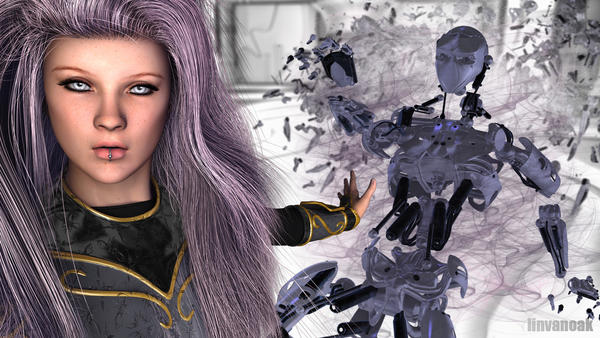Render speed comparison between 3Delight and Octane?
 linvanchene
Posts: 1,382
linvanchene
Posts: 1,382
I split this out of another thread because I can see a high risk that this may turn out into some "app war" as some moderators call it.
Still I think there is some room for users to actually compare and discuss differences between rendering solutions.
There are allready threads for biased vs unbiased.
Lux vs Octane
3Delight vs Lux
So the Octane vs 3Delight seems to be missing.
Just try to keep it civil. pretty please. %-P
Superdog said:The images rendered with Octane look fantastic. As a point of reference would it be possible for people to post render times in DAZ render engine as well so we can compare time savings and quality?.
This would probably be hard to do in a scientific correct way.
Both 3Delight and Octane have different kind of render settings that will drastically improve quality and render time.
What could be done is comparing 3Delight UE2 with ambient light with Octane "Direct Light Kernel" in "Ambient Mode"
Ambient mode means there is no "bleeding" of color into the scene. In Octane the Ambient Mode is considered as the low quality test mode.
For high quality final renderings one would have to compare
3Delight UE2 with indirect lights w/Directional shadows mode... and Octane Render "PMC" kernel that also features indirect light.
- - -
The main issue that makes direct comparison impossible:
Can anyone show any 3Delight render in DS of a complex scene that was ever created with UE2 with indirect light?
On the old forum adam once did a test comparing the different modes of UE2. Even a simple sphere on a plane took a lot longer to render with indirect light active in UE2.
http://forumarchive.daz3d.com/viewtopic.php?t=173382&postdays=0&postorder=asc&start=0
To put it different with 3Delight it is currently not possible to render with indirect lighting active in any reasonable quality / time relationship.
Please correct me on that if you have made some images with indirect light and "color bleeding" with 3Delight.
From my point of view it was exactly this lack of indirect lighting that made people turn to Reality and Luxrender.
And it is exactly the "bleeding" effect of colors that makes images look so much more realistic.
From that point of view there really is not much point in comparing render speeds.
It is not so much about the speed but the more "realistic" quality that can be achieved with other rendering solutions.
But there are enough threads on that topic allready...
- - -
My personal test render to compare speed:
My personal stress test was the "Vanilla" image with fiber hair I allready posted.
The main idea was to see how octane deals with fiber hair.
I did not pay any attention to recreate the DS materials.
The 3Delight UE2 version with default UE2 and 1 directional light took more than 48 hours.
The Octane Version default "Direct Light" "Ambient Mode" version took about 50 minutes.
on a
Win 8 Pro 64bit | Asus GTX660 Ti DCII OC, 2048MB GDDR5, 6008/967 MHz | AMD Phenom II X6 2.8GHz | 16 GB RAM
scene info.
Total Vertices :
1120546
Total Triangles :
865
Total Quads :
624195
Total Faces :
625060
- - -
For the sake of this test I post both images here.
The 3delight version is the one with the cyborg. The Cyborg and the background are composited on another layer in photoshop.
The Octane version is the one with the character alone. The octane version features depth of field.
- - -
All in all from my experience so far I can say that Octane is 10-20 times faster in ambient mode.
If you are comparing high quality indirect lighting modes that may be even a much higher factor.
- - -
If someone has made more test images with 3delight and octane please share.
- - -
In the end there is one important thing to remember:
Each of the render engines available has their plus points and also their flaws.
There probably will never be one solution that is better for all cases.
It will always depend what the user wants to achieve.
- - -
The downside of the faster solution:
In octane you will not find any cartoon shaders and displacements maps will not be supported for probably quite a long time.
You also have to deal with VRAM limits. There is not unlimited space available for textures and maps.
You need a Nvidia Graphic Card. You will have to spend some additional money for licence fees.
But I guess at least something is certain. Octane is faster.






Comments
In my view, anyone who calls this an app war is misguided. You are referring to the same app: DS. These are different render engines that run under that app. Any objective analysis should be considered fair and useful for the community, at large. Real-time engines may be the way of the future and it behooves us to understand the advantages/disadvantages of each approach.
Isn't it difficult to compare Octane and 3Delight as one is an unbiased render engine and one is a biased?
Right on point.
As I tried to explain in the first point if we compare then we should at least compare some render modes that share similar traits.
The one thing you can do is make unbiased render engines behave in a more biased way by removing or at least limiting the random variables.
Exmaples:
In both luxrender and octane you can change how samples are shot out into the scene.
Instead of using "realistic" random patterns you can restrict the search for sample points to those areas that are more likely to be needed for the image.
- - -
The question then is why would you want unbiased render engines to behave more like biased ones?
The answer then would be:
If you are looking for more consistent results. When rendering animations it is preferable to use more biased render modes.
In luxrender that would be the exphoton map mode.
http://www.luxrender.net/wiki/Intro_to_ExPhotonMap
In octane that would be the direct light kernel with ambient mode.
Got no link for that one sorry.
- - -
Random fireflys can be quite noisy if they are in different locations in each frame.
- - -
In any way both of those modes could be compared to 3Delight UE2 default becasue they are more on the biased end..
- - -
UE2 is not the only indirect light option available in Studio.
One can use an IDL camera (quick and simple to create, though not well documented)
One can use the scripted 3delight and point cloud occlusion.
You'll get no argument from me that UE2 is slow (uber soft are faster.. but I don't think we'd be comparing apples to apples), but its good when you get the settings right and it can be worth the wait. The other options seem to me to be equally good, and much faster.
If you are going to dig under the hood enough to use an external renderer, why would you not explore the options available in the program as well?
Yes, but Octane also has limitations. It only works on some high end graphics cards. As I understand it, even on the best graphics cards it is limited to 144 RGBA textures in a scene. The size of a scene is limited by the RAM on your graphics card.
And, of course, it costs a few hundred dollars.
Graphics cards will be getting more powerful over time, and the number of textures supported will go up. CUDA apparently has a way of supporting unlimited numbers of textures in the newest graphics cards, but Octane is not using it yet. Octane and other GPU based render engines will increase in capacity over time, which will make them more realistic as mainstream render engines.
Thanks for the example Linvanchene. Wow! 48hrs vs 50mins and the Octane render looks much more realistic. If that's the general speed and quality of Octane then it definitely seems worth the money. If they had a version for Cararra as well then it would be perfect.